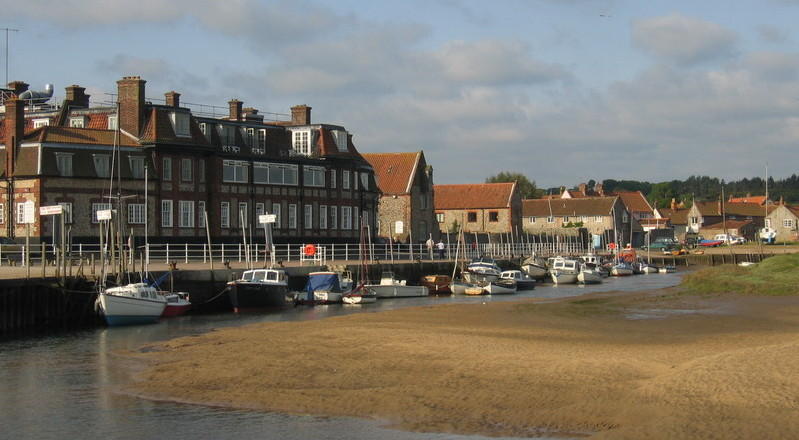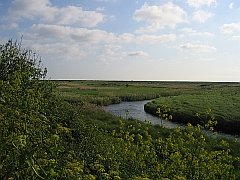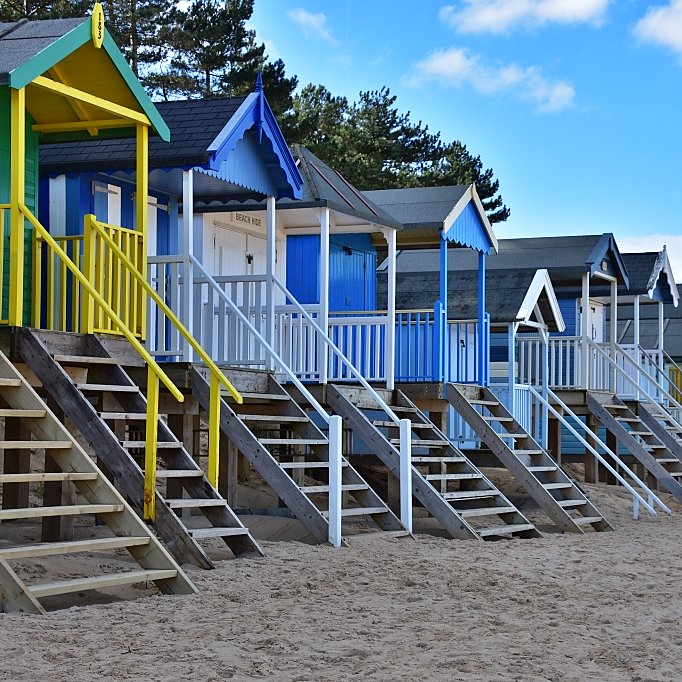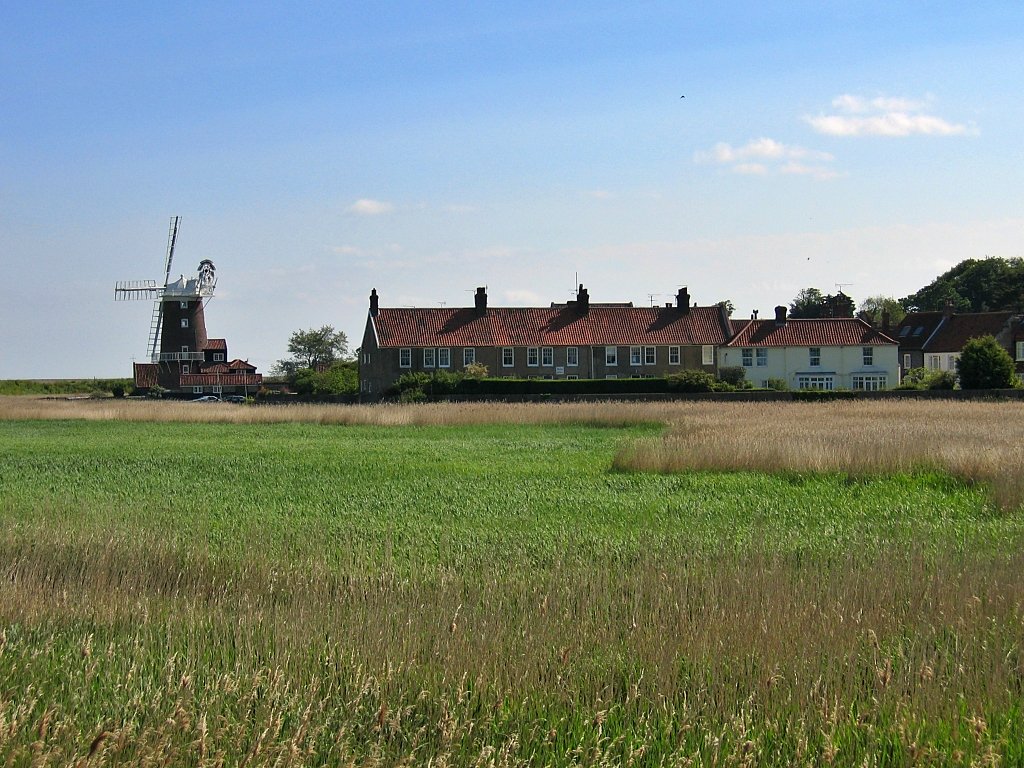Exploring Hunstanton
Living in a land-locked county in the middle of England, we do like to head east now and again to see the sea and remind ourselves that we live on an island in the Atlantic Ocean. For us, it feels like a special day out, and we enjoy taking a walk in the sea air and - on rare occasions - a quick dip in the chilly sea. We’ve taken the Norfolk coast to our hearts and regularly travel up for a day out. We’ve been visiting he pretty coastal resort of Hunstanton for over ten years and on one visit popped in to see an exhibition in the Heritage Centre. There's a lot more to Hunstanton than the beach, the long promenade, or the famous cliffs. The information on the town’s history, architecture, and gardens was fascinating, and we promised ourselves to explore more on our next visit.
Many people travel to Hunstanton on the northwestern tip of the Norfolk coast for a day out or a holiday by the sea. Hunstanton is a pretty seaside resort that was built by the Victorians for this purpose and that has retained its charm over the years. Yes, it has its beaches, fair ground, amusements, and everything that most families want to have fun beside the sea, but if you look closer there’s plenty more to discover!
There’s a flat two-and-a-half-mile promenade or cliff walk to stretch your legs, historical and geological interest, original Victorian and Edwardian architecture, and a shipwreck. The Hunstanton and District Society has devised a selection of trails around the town which delve into its history and development. And whilst learning about Hunstanton you get some fantastic sea views!
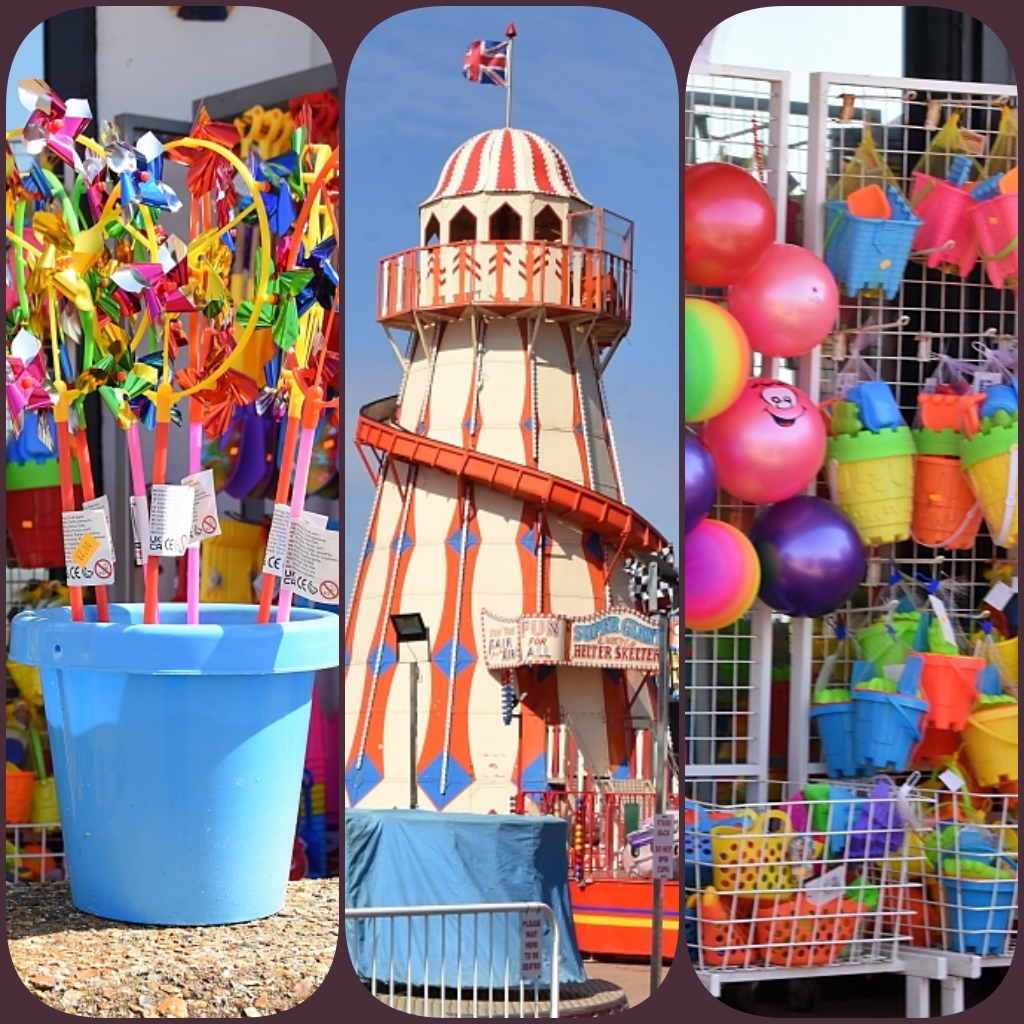 There's Plenty of Fun to be had in Hunstanton © essentially-england.com
There's Plenty of Fun to be had in Hunstanton © essentially-england.com
The Birth of the New Town
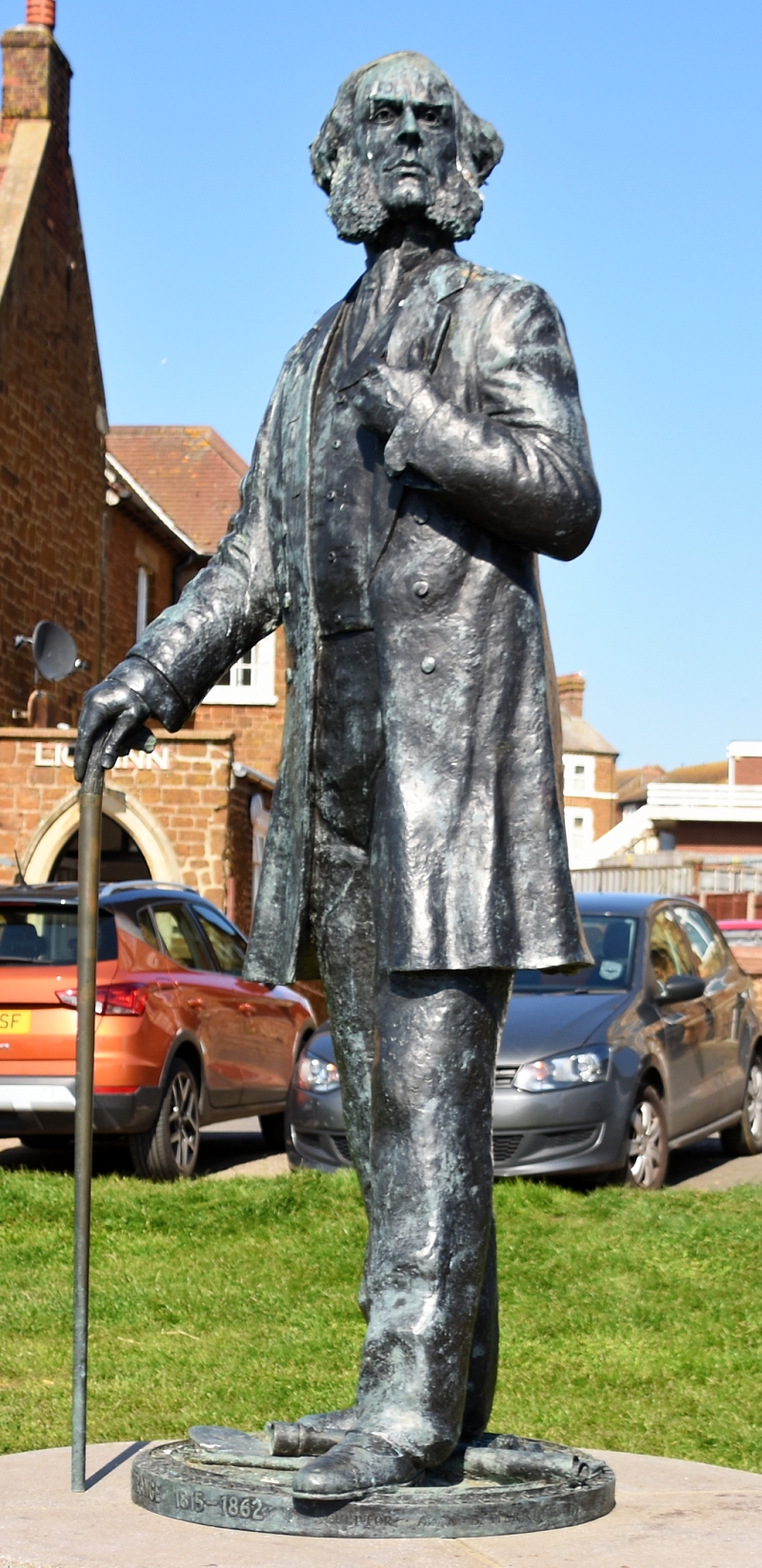 Henry L'Estrange Statue
Henry L'Estrange Statue © essentially-england.com
During the Victorian period, going to the sea to take the water and air became very popular for wealthy people who had the time and money to travel. Henry L’Estrange Styleman le Strange, whose family home was Hunstanton Hall in Old Hunstanton, realised the potential of the coast around him and proposed the idea to build a new town next to the sea, a discrete distance way away from his own home!
The new town was going to be of high standard, built from local Carstone rock, and with all the amenities wealthy travellers required. Building started in 1846, but it wasn’t until the railway arrived in 1862 that the new town’s growth accelerated rapidly. The new town was called Hunstanton St. Edmund’s, but is now just called Hunstanton, or “Sunny Hunny”.
Highlights of Hunstanton
My list of Hunstanton highlights follows the order in which we saw them during one of our visits. We usually park in the Clifftop Carpark as it has great views, is easy to reach, and has plenty of space. From there, it's a lovely walk along the cliffs and into town or you could go in the other direction to the sandy beach of Old Hunstanton.
The Coastguard Lookout
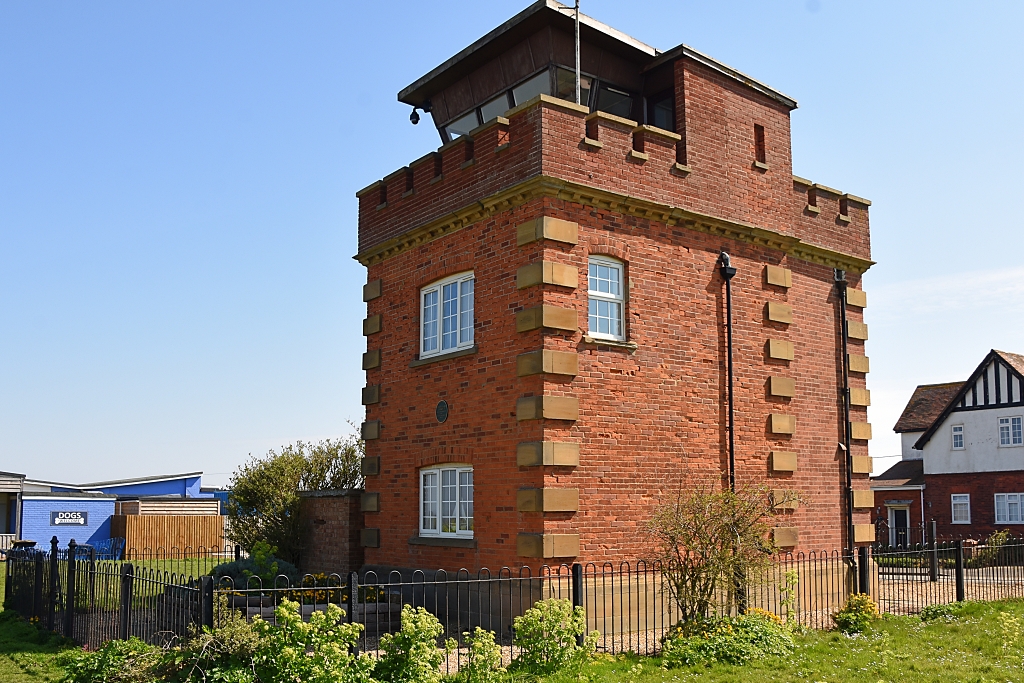 The Coastguard Lookout © essentially-england.com
The Coastguard Lookout © essentially-england.comThe Coastguard Lookout was built in 1906 as a Marconi Wireless Station and was used during both World Wars to listen to German radio transmissions and help trace their fleet and zeppelin flights. In 1943, King George VI and Queen Elizabeth visited the listening post with their two daughters, Princess Elizabeth and Princess Margaret. It has now been converted to a comfortable holiday cottage which you can rent through Booking.com.
The Lighthouse
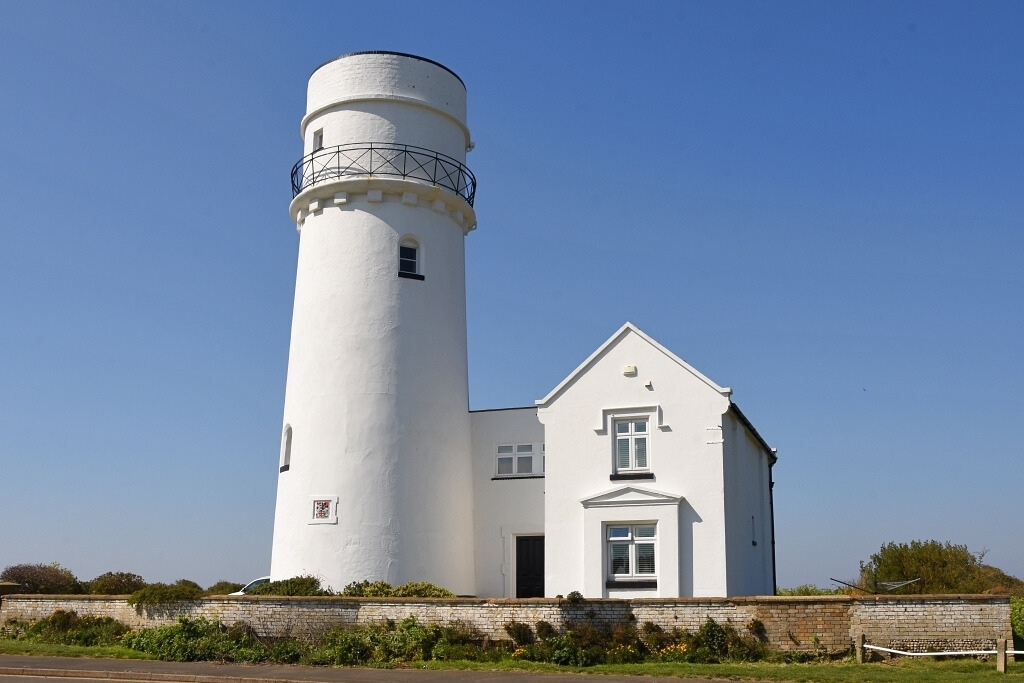 Hunstanton Lighthouse © essentially-england.com
Hunstanton Lighthouse © essentially-england.comThere has been a lighthouse on the site of the present Old Hunstanton Lighthouse since 1665 to aid sailors into the safer water of The Wash and on towards the major ports of King's Lynn and Boston. The lighthouse has been replaced many times since then and the lighthouse of 1776 became the first in Britain to use oil lamps instead of a coal fire, and the first in the world to use a parabolic reflector. Work started on the current lighthouse in 1836 and the lantern was lit for the first time in September 1840. Not surprisingly, due to the great views from above cliffs, the lighthouse soon became the new town’s first tourist attraction. It was in use until 1922 when the lantern was finally extinguished after improvements were made to the Inner Downsing Lightship. The “Old Lighthouse” is now a holiday cottage.
And just to complete the story, the Inner Downsing Lightship has been fully restored and is now a bed and breakfast near Rochester in Kent. It can be booked through Booking.com.
St. Edmund's Chapel
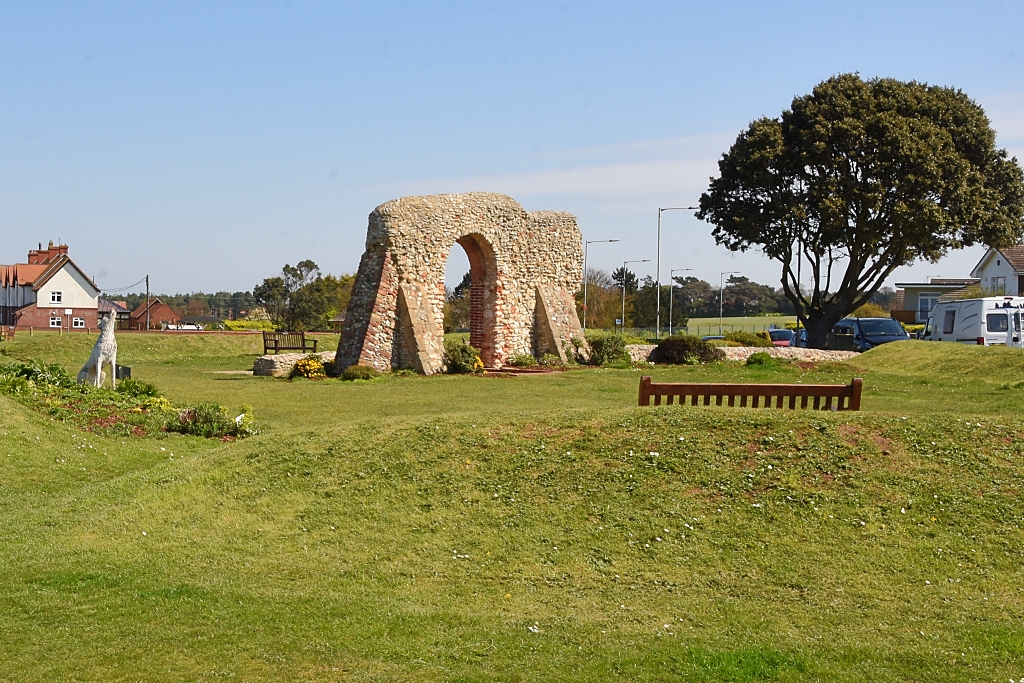 St Edmund's Chapel © essentially-england.com
St Edmund's Chapel © essentially-england.com 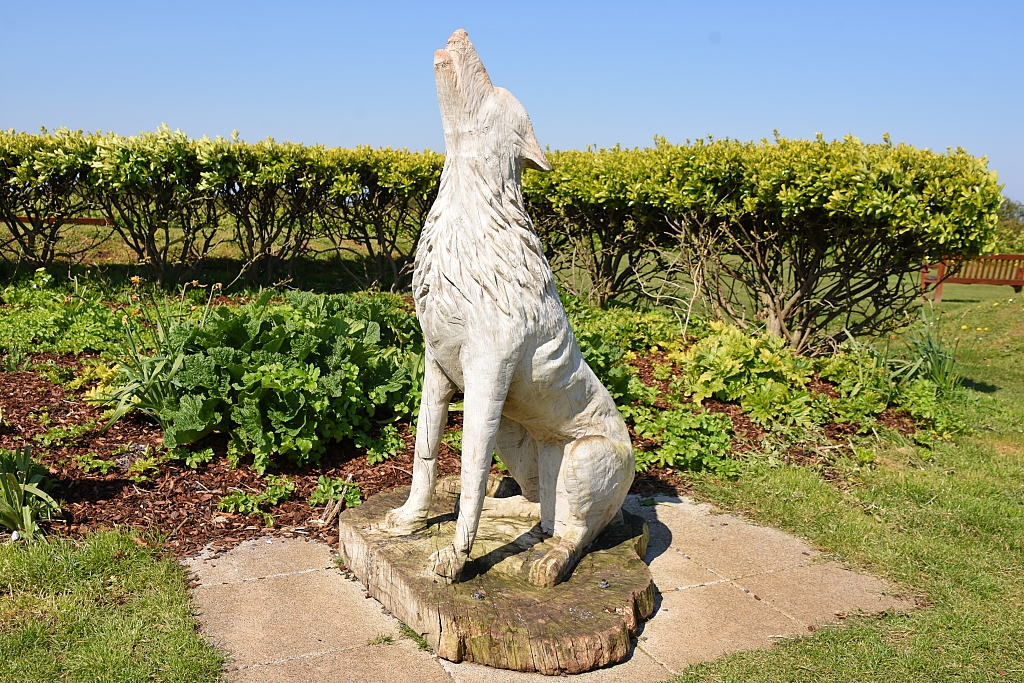 Wolf Sculpture at St Edmund's Chapel
Wolf Sculpture at St Edmund's Chapel © essentially-england.com
Only ruins remain of St. Edmund’s Chapel, which was built around 1272 in memory of St. Edmund who was King of East Anglia and one-time patron saint of England. Fourteen-year-old Edmund was the last member of the Wuffing (Waffa means wolf in old English) family who'd ruled East Anglia for over 200 years. He had spent his childhood in Saxony and landed below the Hunstanton cliffs in 855 to claim his kingdom. After 14 years of peaceful rule, he was captured near Thetford while battling Viking raiders. King Edmund was tied to a tree where, due to his refusal to surrender his Christian faith, he was whipped, beaten, shot by arrows, and beheaded. The Vikings left the body and ran off into the forest to hide his head, denying Edmund a Christian burial.
Legend has it, that while Edmund’s followers were searching for his missing head, they heard his voice call “Here, here, here” to them from within the forest where they found a large grey wolf standing guard over Edmund’s head. After putting the head beside his body, they found that the head and body fused perfectly together and believed this to be a sign of sainthood and the first of many miracles connected with St. Edmund.
Centuries later, in Bury St Edmunds where Edmunds body rests in the Abbey, a small stone coffin was found. The bones inside the coffin were identified as belonging to a wolf. Were these the remains of the great grey wolf?
The Lookout
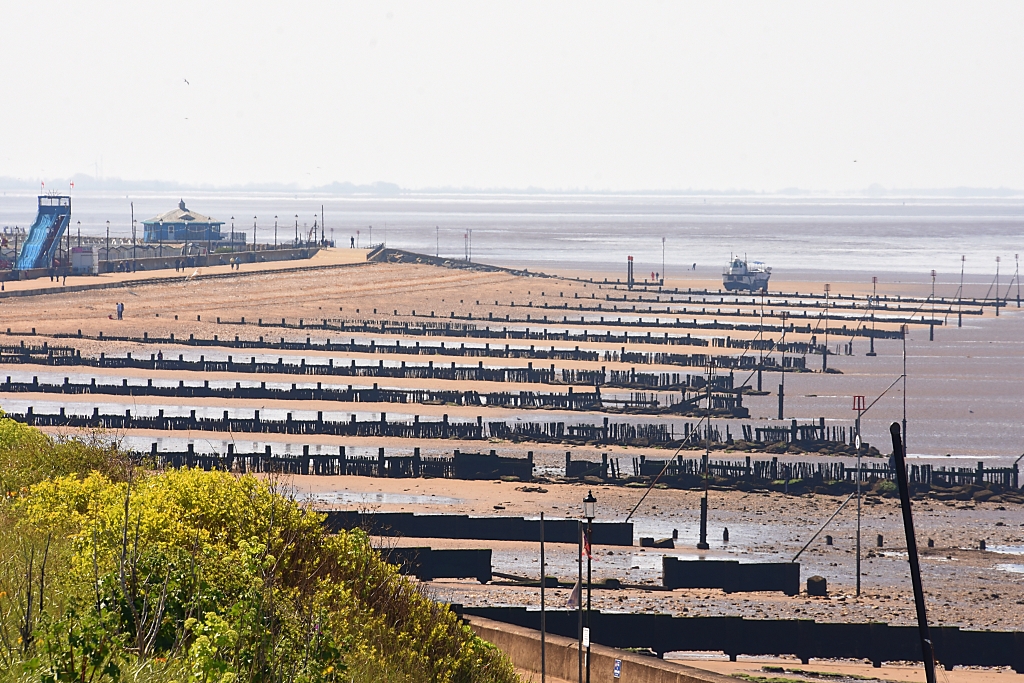 Hunstanton Beach and Lincolnshire Coast from the Lookout
Hunstanton Beach and Lincolnshire Coast from the Lookout © essentially-england.com
The Lookout gives an opportunity to take in the glorious views along the Hunstanton coastline, and if the weather is clear, across The Wash to Lincolnshire. Its elevated position is an excellent place to get a clearer look along the cliffs if the tide is high and there is no beach access. There are a couple of benches to sit on and take in the sea views, a map which points out things of interest on the horizon, and a telescope. And, strangely, if you’re here as the sun goes down you may get to see a beautiful sunset as Hunstanton is the only east coast resort that faces west!
Esplanade
Gardens
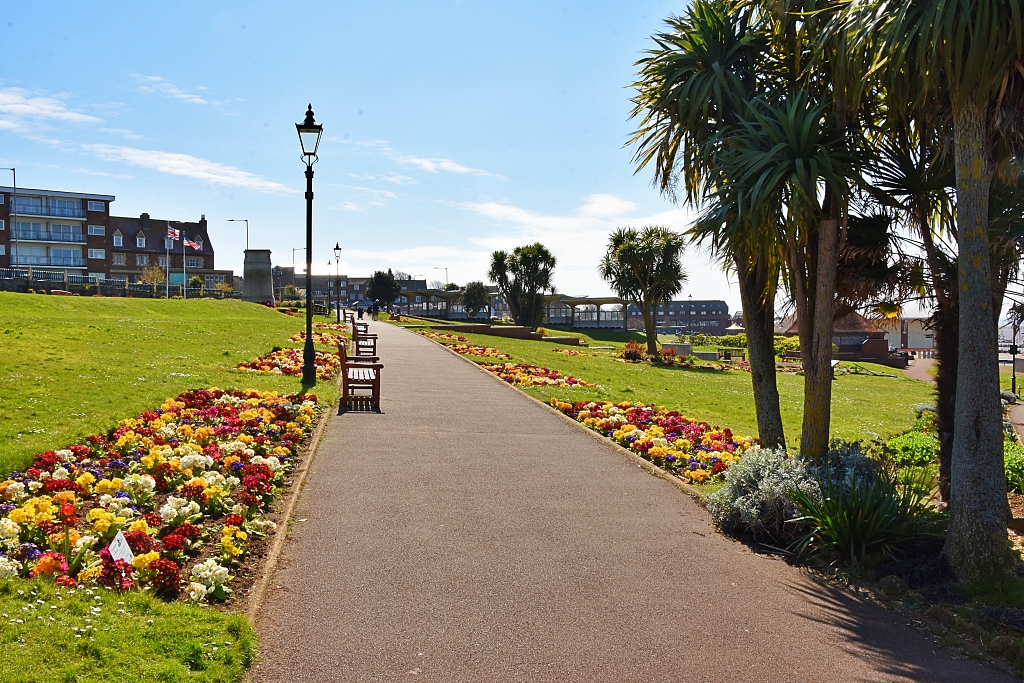 Esplanade Gardens © essentially-england.com
Esplanade Gardens © essentially-england.comYou walk through the Esplanade Gardens on the Reis Leming Way, named for the American airman who was awarded the George Medal for his bravery while rescuing people during the great flood of January 1953. These pretty gardens include bowling greens, crazy golf, play areas, the Cenotaph, Flood memorial, and colourful planted areas all with a great view out to sea.
The Green
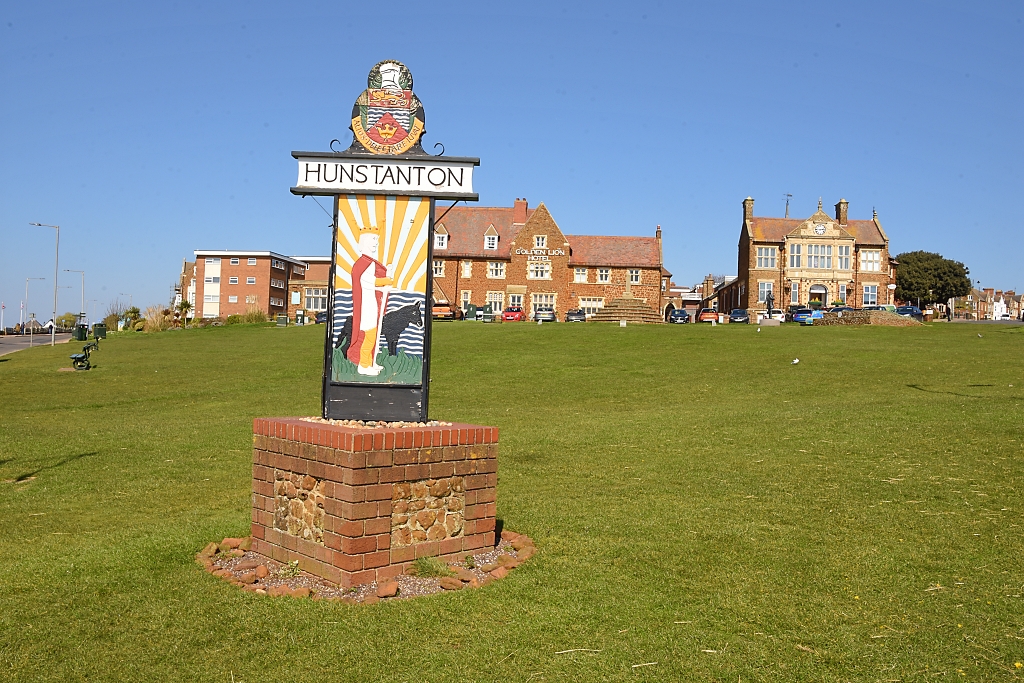 The Green © essentially-england.com
The Green © essentially-england.com 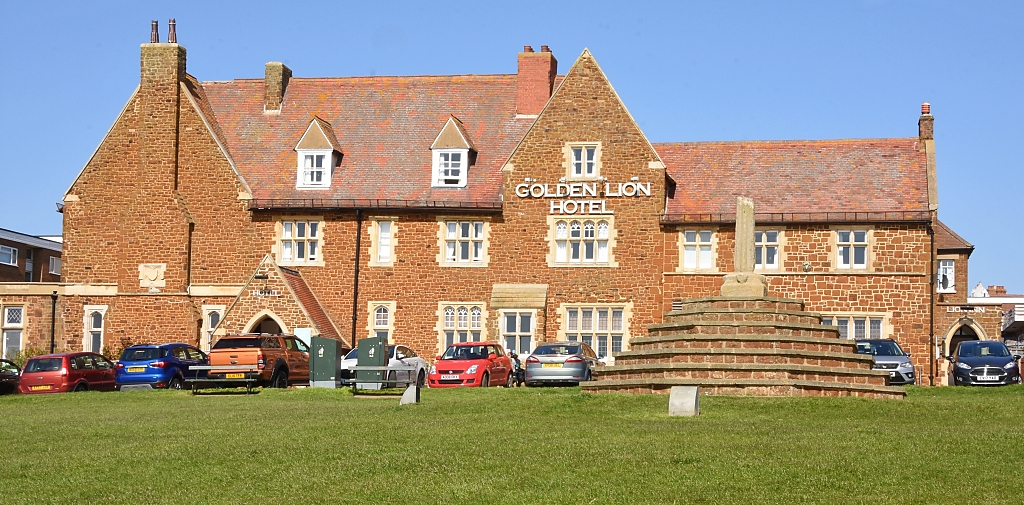 Golden Lion Hotel © essentially-england.com
Golden Lion Hotel © essentially-england.comThe Green is a triangular grassed area that has a prominent position within Hunstanton and more fine views out to sea. This was the heart of the new town of Hunstanton. Around the edges of The Green are some of the first buildings of the new town.
The Golden Lion Hotel was the first building built in Hunstanton in 1846. It was originally called The New Inn. Next door to the hotel is the Town Hall which was built in 1896 and now includes the Tourist Information Centre.
One thing that has disappeared from the landscape is the 800-foot-long pier which would have stood directly below The Green but was washed away in a fierce storm in January 1978. That’s the second wild weather event I’ve mentioned that happened in January. Perhaps it’s wise to avoid visiting Hunstanton during January!
On the Green are the town sign which shows the towns coat of arms and the image of the Saxon King Edmund and a grey wolf, a statue of Henry L’Estrange, the founder of Hunstanton, and an ancient cross that is thought to have come from Snettisham.
Hunstanton Cliffs
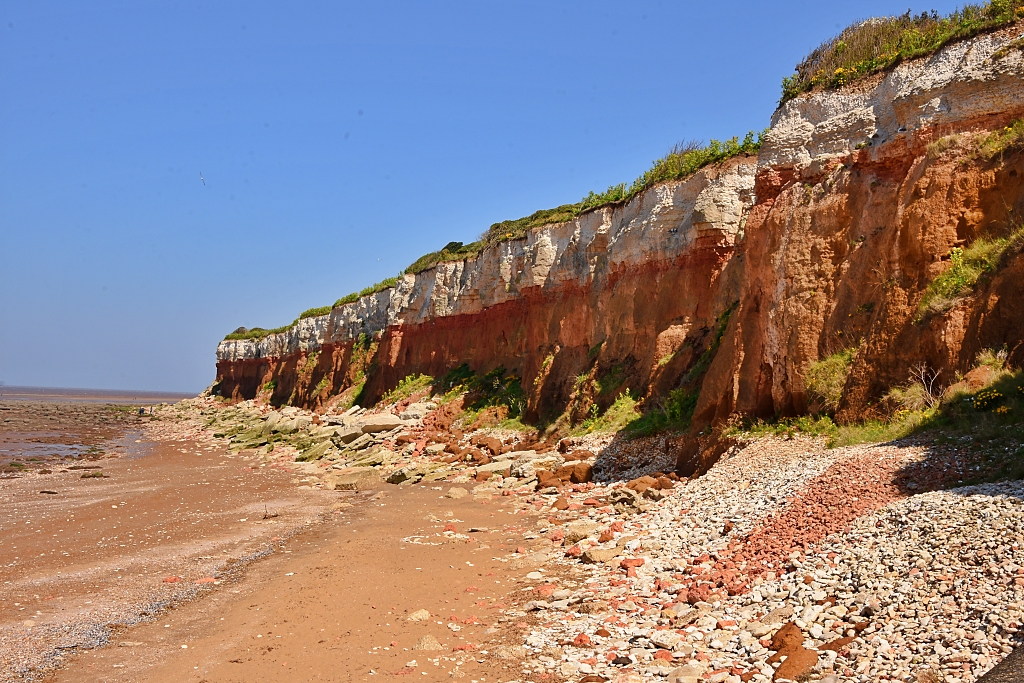 Hunstanton Cliffs © essentially-england.com
Hunstanton Cliffs © essentially-england.com 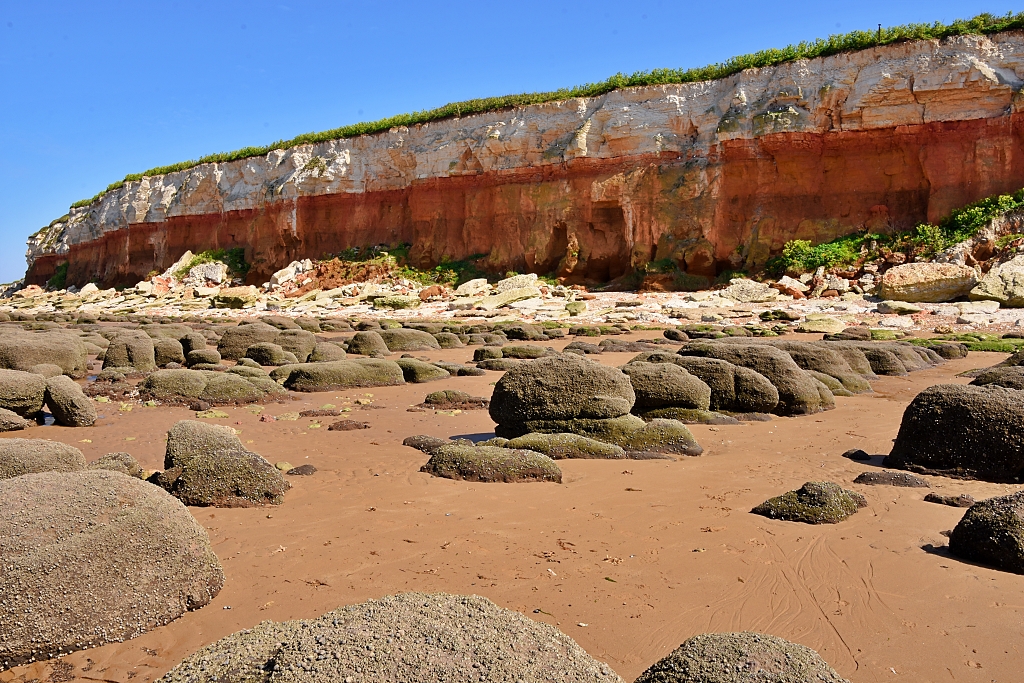 Hunstanton Cliffs and Beach © essentially-england.com
Hunstanton Cliffs and Beach © essentially-england.comThe colourful striped cliffs of Hunstanton are a favourite attraction and were formed millions of years ago when this area was at the bottom of a warm tropical sea. Even to my untrained geologist’s eye there are three distinct layers, the youngest being the white chalk layer at the top of the cliff.
Believe it or not, this white chalk layer was created about 93 to 99 million years ago from the remains of microscopic organisms that lived in a deep warm sea. The purity of the chalk hints that the sea was a long way away from land as there is no staining from landside debris being swept out to sea.
The next layer down is red chalk which is roughly 99 to 108 million years old. Here the chalk has been contaminated by limonite, a form of iron ore, to give the chalk its red colour.
The oldest layer, exposed at the bottom of the cliff, is the red/brown Carstone which was laid down around 108 to 112 million years ago. This rock is made up from sand particles bonded together with iron oxide. The presence of small, rounded pebbles within this layer implies that the sea was shallow, and waves lapped and polished the pebbles.
Although the cliffs are beautiful and offer great fossil hunting, they are also dangerous as rubble can fall at any time. There is plenty of debris on the beach for fossil hunting and there are also some great rock pools to search for sea life. Happy hunting!
Stream
Trawler Sheraton Wreck
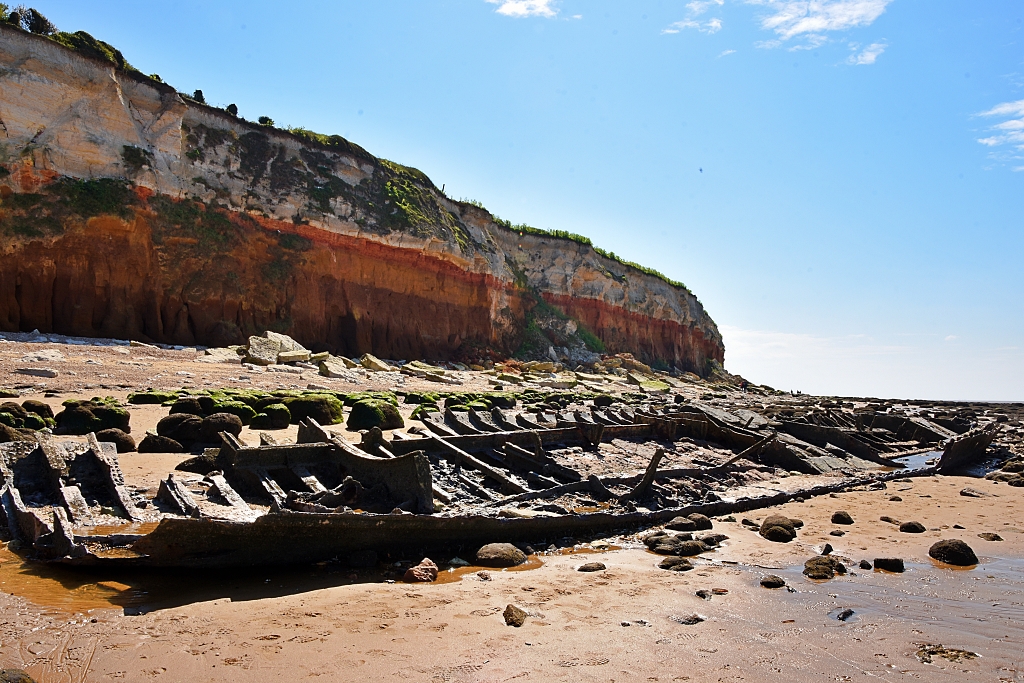 Steam Trawler Sheraton Shipwreck © essentially-england.com
Steam Trawler Sheraton Shipwreck © essentially-england.comThe shipwreck of ST Sheraton can be seen during low tide on the beach below Hunstanton cliffs. This once proud trawler was built in 1907 and was part of the fishing fleet operating from Grimsby in Lincolnshire. She was a strongly built steel ship, about 130 feet long and 23 feet wide, and was made to withstand the often-rough conditions of the North Sea. During the two World Wars, she was commandeered by the Royal Navy and used for minesweeping and anti-submarine missions. At the end of WWII, ST Sheraton was robbed of valuable parts, painted brightly, anchored in The Wash, and used for target practice by the Royal Air Force. After a storm in April 1947, she broken away from her mooring and came to rest on the beach in Hunstanton. There’s only part of the hull left now, but all kids, big or small, would love to see a shipwreck!
The Railway
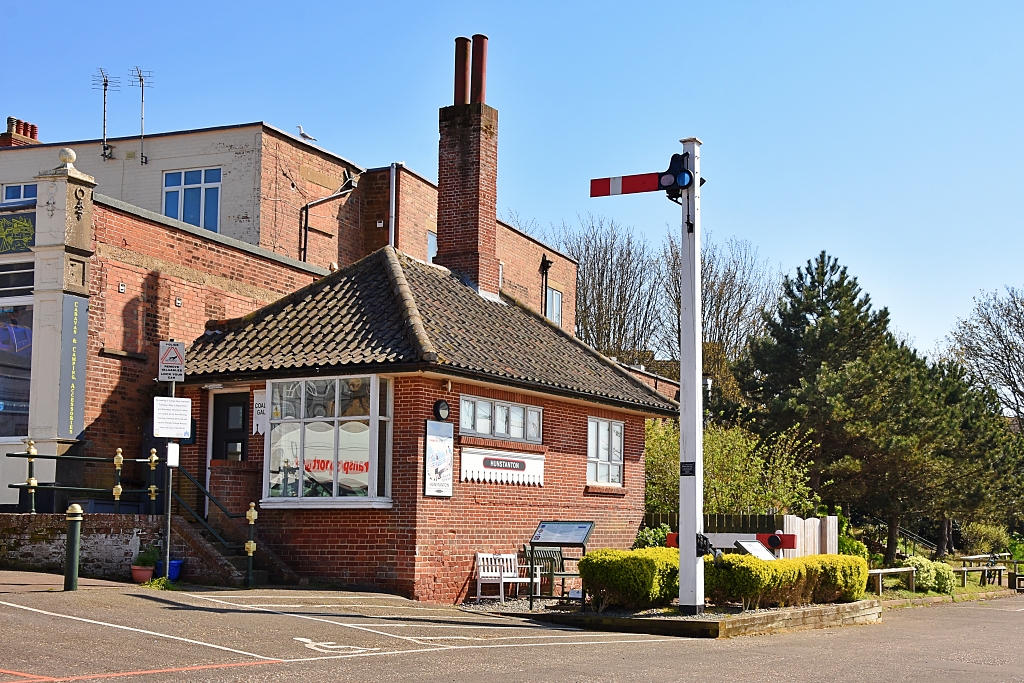 The Railway Garden and Coal Office © essentially-england.com
The Railway Garden and Coal Office © essentially-england.comHunstanton's railway station opened on the 3rd of October 1862, just a few months after the death of Henry L’Estrange. It had taken just ten months to build the 15-mile railway line from King's Lynn, allowing passengers to travel directly from London, and it went on to be one of the most profitable branch lines in England. The line was also used by Royalty and Heads of State, who would disembark at The Royal Station Wolferton when they visited the Sandringham Estate. Hunstanton reached the peak of its popularity in the 1950’s when 22 trains a day arrived from all over the country!
The railway probably survived the 1960’s Beeching cutbacks because of its Royal connection with Sandringham. However, after the Royal Family agreed to use King’s Lynn station and the increase in car use, the last train left Hunstanton on the 3rd of May 1969.
All that is left of the railway is a small coal office and a memorial garden. Much of the station area, sidings, and engine sheds has now been turned into car parking.
Boston Square Sensory Park
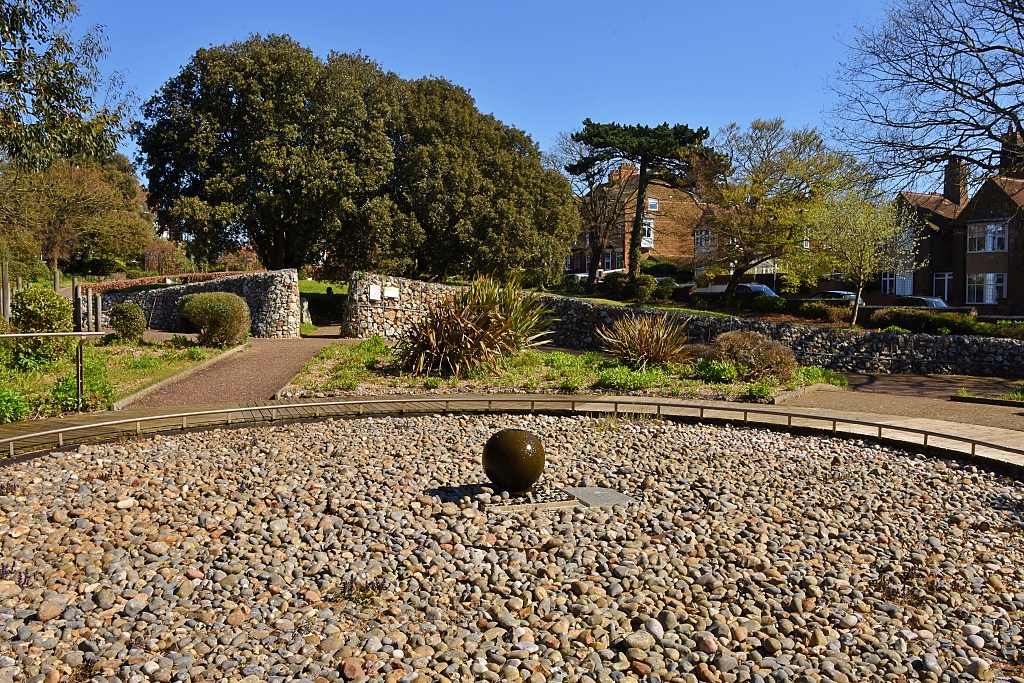 Boston Square Sensory Park © essentially-england.com
Boston Square Sensory Park © essentially-england.comBoston Square Sensory Park is an easy access garden that is split into different rooms representing the geography around Hunstanton. There are shingle and water features inspired by the beach, grass lawns contoured to look like waves, and meadow grassland from the chalk cliffs. It’s all finished off with colourful planting, trees, and a stone circle!
Arts and
Crafts Architecture
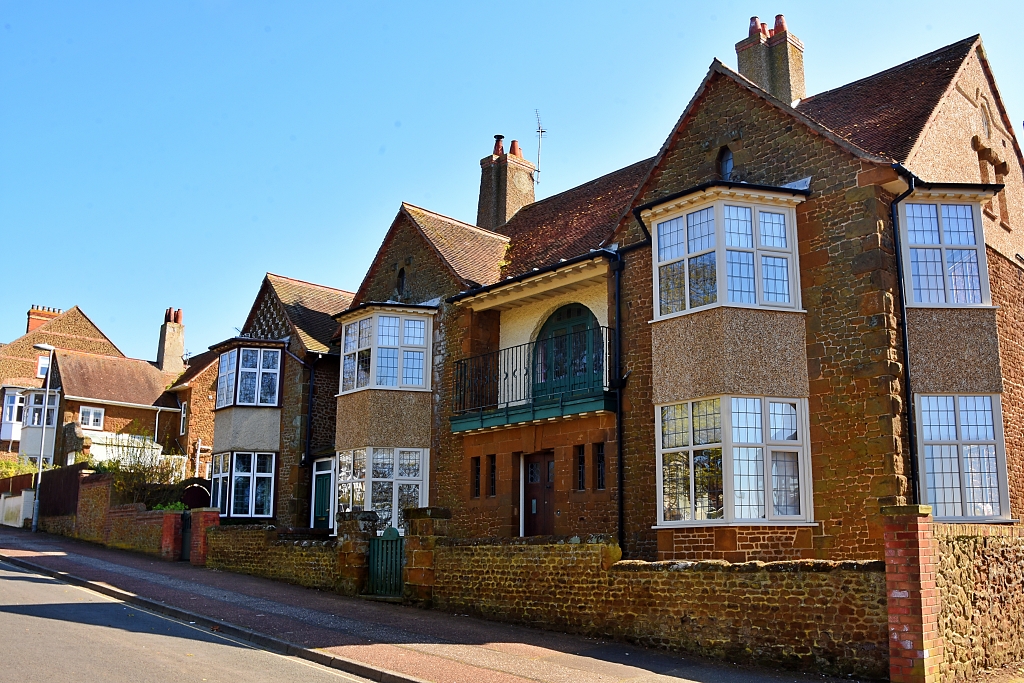 Arts and Crafts Houses © essentially-england.com
Arts and Crafts Houses © essentially-england.comThe town planners of Hunstanton stuck to their guns and continued to use highly regarded architects to design new buildings. People such as George Skipper and Herbert George Ibberson designed some of the Arts and Crafts buildings around the 1900’s. The features they added included chequerboard patterns, archways, circular windows, and sloped chimneys with local Carstone used to highlight the detail.
Fish and Chips
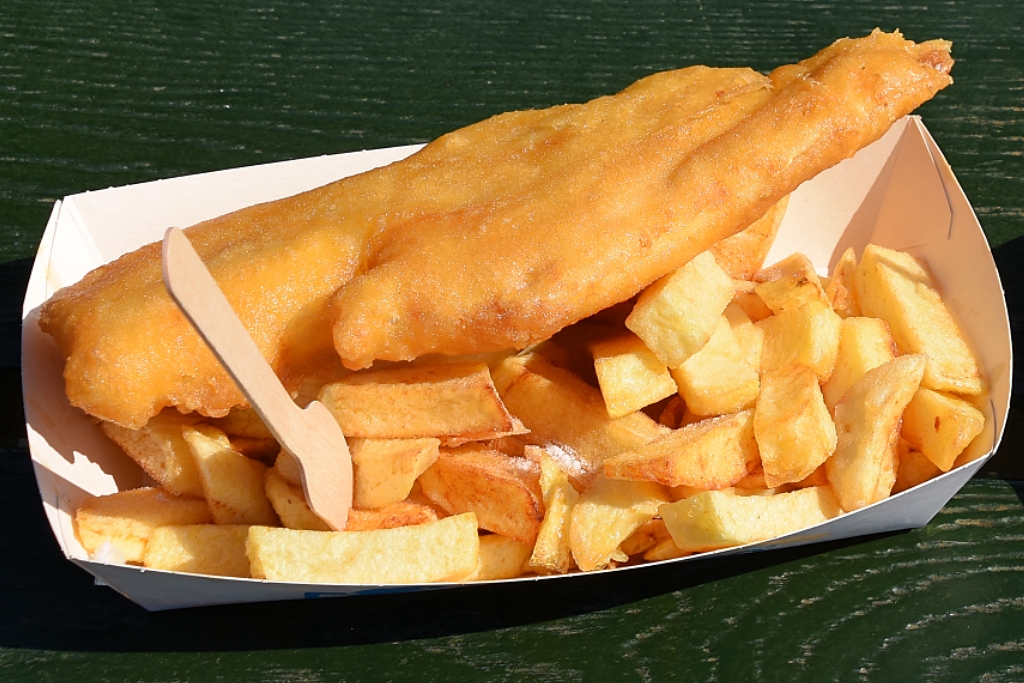 Tasty Fish and Chips © essentially-england.com
Tasty Fish and Chips © essentially-england.comWe believe
that fish and chips taste better when sitting next to the sea and treat
ourselves to this tasty English take away when the opportunity arises. We’ve
tried several of Hunstanton’s fine fish and chip shops, but on our last couple
of visits, Five Frying Fish has been our choice and we sat on a bench near the
bandstand overlooking the sea with our bounty.
I’m convinced we’ll be adding more highlights to this list, as we seem to learn more about Hunstanton after each visit. If you would like more details of walks around Hunstanton, then take a read of our Hunstanton Discovery Trails page. We list six different trails around Hunstanton that are suitable for young or old explorers. Or, if you want to be a bit more adventurous why not try walking along the Norfolk Coast Path to Thornham. We did a 5-mile walk that took us through some stunning scenery and then got the bus back to Hunstanton from Thornham. You can read about our Hunstanton to Thornham Walk here.
For more information about Hunstanton and events and activities please read the Hunstanton Society website.
Are You Planning a Holiday in Norfolk?
Where You Could Stay
Norfolk has no shortage of fabulous holiday accommodation whether you want to spend time on the beach, love boating or want to explore inland. You may covet a tiny fisherman's cottage like the one in Blakeney we kept returning to. You may like something larger and more modern like a loft overlooking the Norfolk Broads, or the right place for you may be a chic city apartment perfectly placed to explore Norwich...
To see other holiday cottages in Norfolk click here. Or check out holiday cottages in other parts of England by clicking here.
Or you could try a family orientated holiday resort in Lincolnshire as there's plenty of choice...
If you need to find a hotel, then try one of these search platforms...
What You Could See and Do
It's next to impossible to be bored in Norfolk, there's just so much to do and see. The list below includes some of our favourite places
- Explore Norwich with its shops and two cathedrals and pay a visit to Norwich Castle and its teapot museum.
- Visit Admiral Lord Nelson's birthplace at Burham Thorpe and read the report of the Battle of Trafalgar in a copy of The Times from 1805
- Spend a day at Sandringham and Castle Rising Castle
- Take a ride on the Holt to Sheringham Railway and explore the beautiful little town of Holt and the seaside town of Sheringham
- Explore the ruins of Castle Acre and Castle Acre Priory
- Shop in Burnham Market
- Wander around the small town of Blakeney, explore the church and harbour before making an attempt to reach the seals at Blakeney Point
- Admire the famous windmill and go birdwatching in Cley-next-the-Sea
- Be wowed by the rhododendrons in Sheringham Park
- Visit Anne Boleyn's family home, Blickling Hall, or explore Oxburgh Hall, a fabulous manor house with a moat.
- Go wildlife spotting while walking through the Cley marshes from Blakeney or to the small village of Morston and its quay.
- Or even fish for crabs and wander along the famous pier at Cromer.
For more inspiration try our Things to do in Norfolk page.
For more holiday ideas return from our Hunstanton page to the Norfolk page.





